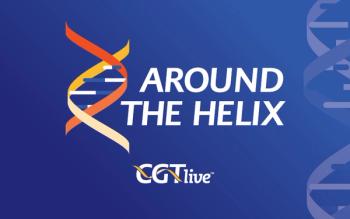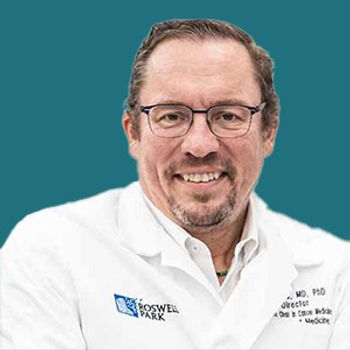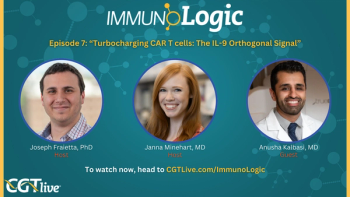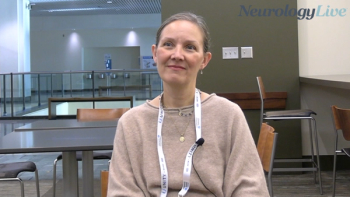
Optimal Use of CAR T-Cell Therapy, Bispecifics, and Other Novel Strategies Will Determine the Future of DLBCL Therapy
Alexey Danilov, MD, PhD, discussed the importance of reassessing sequencing stratagems in the face of a growing toolbox of targeted therapies in DLBCL.
This interview originally appeared on our sister site,
CGTLive®'s sister site, OncLive®, recently interviewed Alexey Danilov, MD, PhD, the Marianne and Gerhard Pinkus Professor of Early Clinical Therapeutics, medical director of the Early Phase Therapeutics Program for the Systems Clinical Trials Office, codirector of the Toni Stephenson Lymphoma Center, and a professor in the Division of Lymphoma in the Department of Hematology & Hematopoietic Cell Transplantation at City of Hope in Duarte, California, about the current landscape of care for relapsed/refractory diffuse large B-cell lymphoma (DLBCL). Danilov covered topics including considerations for bridging therapy when giving chimeric antigen receptor T-cell (CAR-T) therapy to patients with relapsed/refractory (r/r) DLBCL, the unanswered questions that remain with regard to ideal sequencing of treatment in light of the expanding toolbox of available treatment options, and the potential parts to be played by BTK degraders, CD19-targeted bispecific antibodies, and allogeneic CAR-T therapy across B-cell malignancies in the future.
"We will see a lot of new drugs in the next 10 years, which will generate even more questions about both sequencing and determining the best approach to minimize toxicities,” Danilov emphasized.
In a
OncLive: What are some of the factors to weigh when considering CAR T-cell therapy in DLBCL?
Danilov, MD, PhD: The approved CAR T-cell therapies are all CD19-based, and this is another area that is evolving. There are very good data by now that [show] bendamustine-based therapies negatively impact the efficacy of subsequent CAR T-cell therapies in DLBCL. At this point, we try to avoid bendamustine. The combination of bendamustine and tafasitamab-cxix [Monjuvi] has been approved in the relapsed/refractory setting in DLBCL and has become a somewhat widely used regimen. However, CAR T-cells should not be recommended for these patients because of the immunosuppressive, T-cell suppressive effects of bendamustine.
There is another consideration of whether to use CD19-targeted therapies in patients who are planning to undergo CAR T-cell therapy: some evidence shows that there may potentially be CD19 loss following CD19-targeting therapies. However, the data in this space are very limited, and the data that we have so far are fairly encouraging, where patients who have received loncastuximab tesirine-lpyl [Zynlonta], for example, or tafasitamab, still did well with CAR T-cell therapy.
In fact, some interesting data are suggesting that tafasitamab pretreatment prior to CAR T-cell therapy may actually increase CAR T-cell efficacy due to a more measured and regulated onset of CAR T-cell expansion.
What is the best bridging regimen prior to CD19–[directed] CAR T-cell therapy? The only area where there is no longer so much controversy is that we should avoid bendamustine. However, in terms of CD19-targeting antibodies or immunotherapeutic agents, there is still a lot of work that needs to be done.
What are some essential factors and unanswered questions regarding treatment sequencing in DLBCL?
We have very good agents in the therapy of DLBCL now, such as CAR T-cell therapies, bispecific antibodies, and CD19-targeted therapies. In terms of sequencing, there is now an emerging question of whether we should be using bispecifics first or CAR T-cells first. Some of this will be driven by logistical issues; some will be driven by whether there is easy accessibility to a tertiary care center that can [administer] CAR T-cell therapy; and some will be driven by patient comorbidities, cost, and other factors.
There are now emerging data in DLBCL [also showing that] bispecific antibodies do work pretty well after [progression on] CAR T-cell therapies in patients, and also vice versa: patients who [progressed on] bispecific antibodies may still respond to CAR T-cell therapy, provided that the antigen is still expressed that was being targeted by the bispecific antibodies. CD20 is what most of these bispecific antibodies target now—at least the ones that are approved.
There is still a lot of debate [regarding] the best approach. Of course, CAR T-cell therapies have been approved for some time. We have very good data, particularly in patients with primary refractory DLBCL or [in those who] relapse early after initial chemotherapy, [showing] that CAR T-cells are essentially replacing ASCT in that space. In later lines of therapy, however, I think we'll see some emerging data in favor of both [bispecific antibodies and CAR T-cell therapy].
Looking ahead, how do you see the treatment paradigm changing in DLBCL and other non-Hodgkin lymphoma subtypes?
It's important to know that there are many other agents [in development] that could further shift the paradigm in the treatment of lymphoid malignancies. For example, in the targeted therapy space, we have a whole class of agents called BTK degraders, which are showing very high efficacy in CLL and some indolent lymphomas, as well.
In the cell therapy space, we have novel targets for CAR T-cells. For example, the BAFF receptor–targeting CAR T-cells, dual-targeting or dual-antigen–targeting CAR T-cells, and allogeneic CAR T-cells [are] an emerging field. In the bispecific antibody space, most agents currently target CD20, but there are now also CD19-targeting bispecific antibodies in development that have shown very high preliminary efficacy.
This transcript has been edited for clarity.
REFERENCE
1. Danilov AV, Sauter C, Phillips T, et al. Perspectives on current challenges and emerging approaches for lymphoma management from the first Bridging the Gaps in Leukemia, Lymphoma, and Multiple Myeloma Conference. Clin Lymphoma Myeloma Leuk. 2025;25(6):e366-e373. doi:10.1016/j.clml.2025.01.005
Newsletter
Stay at the forefront of cutting-edge science with CGT—your direct line to expert insights, breakthrough data, and real-time coverage of the latest advancements in cell and gene therapy.











































